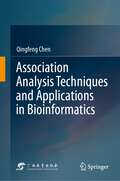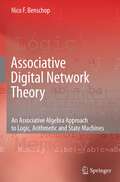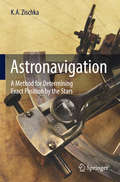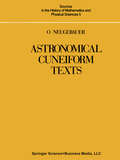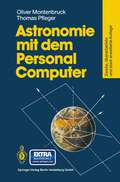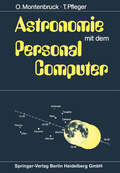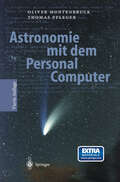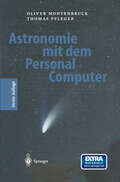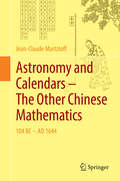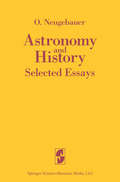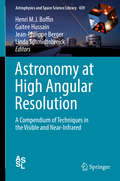- Table View
- List View
Association Analysis Techniques and Applications in Bioinformatics
by Qingfeng ChenAdvances in experimental technologies have given rise to tremendous amounts of biology data. This not only offers valuable sources of data to help understand biological evolution and functional mechanisms, but also poses challenges for accurate and effective data analysis. This book offers an essential introduction to the theoretical and practical aspects of association analysis, including data pre-processing, data mining methods/algorithms, and tools that are widely applied for computational biology. It covers significant recent advances in the field, both foundational and application-oriented, helping readers understand the basic principles and emerging techniques used to discover interesting association patterns in diverse and heterogeneous biology data, such as structure-function correlations, and complex networks with gene/protein regulation. The main results and approaches are described in an easy-to-follow way and accompanied by sufficientreferences and suggestions for future research. This carefully edited monograph is intended to provide investigators in the fields of data mining, machine learning, artificial intelligence, and bioinformatics with a profound guide to the role of association analysis in computational biology. It is also very useful as a general source of information on association analysis, and as an overall accompanying course book and self-study material for graduate students and researchers in both computer science and bioinformatics.
Association Models in Epidemiology: Study Designs, Modeling Strategies, and Analytic Methods (Chapman & Hall/CRC Biostatistics Series)
by Hongjie LiuAssociation Models in Epidemiology: Study Designs, Modeling Strategies, and Analytic Methods is written by an epidemiologist for graduate students, researchers, and practitioners who will use regression techniques to analyze data. It focuses on association models rather than prediction models. The book targets students and working professionals who lack bona fide modeling experts but are committed to conducting appropriate regression analyses and generating valid findings from their projects. This book aims to offer detailed strategies to guide them in modeling epidemiologic data.Features Custom-Tailored Models: Discover association models specifically designed for epidemiologic study designs. Epidemiologic Principles in Action: Learn how to apply and translate epidemiologic principles into regression modeling techniques. Model Specification Guidance: Get expert guidance on model specifications to estimate exposure-outcome associations, accurately controlling for confounding bias. Accessible Language: Explore regression intricacies in user-friendly language, accompanied by real-world examples that make learning easier. Step-by-Step Approach: Follow a straightforward step-by-step approach to master strategies and procedures for analysis. Rich in Examples: Benefit from 120 examples, 77 figures, 86 tables, and 174 SAS® outputs with annotations to enhance your understanding. Crafted for two primary audiences, this text benefits graduate epidemiology students seeking to understand how epidemiologic principles inform modeling analyses and public health professionals conducting independent analyses in their work. Therefore, this book serves as a textbook in the classroom and as a reference book in the workplace. A wealth of supporting material is available for download from the book’s CRC Press webpage. Upon completing this text, readers should gain confidence in accurately estimating associations between risk factors and outcomes, controlling confounding bias, and assessing effect modification.
Association Models in Epidemiology: Study Designs, Modeling Strategies, and Analytic Methods (Chapman & Hall/CRC Biostatistics Series)
by Hongjie LiuAssociation Models in Epidemiology: Study Designs, Modeling Strategies, and Analytic Methods is written by an epidemiologist for graduate students, researchers, and practitioners who will use regression techniques to analyze data. It focuses on association models rather than prediction models. The book targets students and working professionals who lack bona fide modeling experts but are committed to conducting appropriate regression analyses and generating valid findings from their projects. This book aims to offer detailed strategies to guide them in modeling epidemiologic data.Features Custom-Tailored Models: Discover association models specifically designed for epidemiologic study designs. Epidemiologic Principles in Action: Learn how to apply and translate epidemiologic principles into regression modeling techniques. Model Specification Guidance: Get expert guidance on model specifications to estimate exposure-outcome associations, accurately controlling for confounding bias. Accessible Language: Explore regression intricacies in user-friendly language, accompanied by real-world examples that make learning easier. Step-by-Step Approach: Follow a straightforward step-by-step approach to master strategies and procedures for analysis. Rich in Examples: Benefit from 120 examples, 77 figures, 86 tables, and 174 SAS® outputs with annotations to enhance your understanding. Crafted for two primary audiences, this text benefits graduate epidemiology students seeking to understand how epidemiologic principles inform modeling analyses and public health professionals conducting independent analyses in their work. Therefore, this book serves as a textbook in the classroom and as a reference book in the workplace. A wealth of supporting material is available for download from the book’s CRC Press webpage. Upon completing this text, readers should gain confidence in accurately estimating associations between risk factors and outcomes, controlling confounding bias, and assessing effect modification.
Association Models in Epidemiology: Study Designs, Modeling Strategies, and Analytic Methods (Chapman & Hall/CRC Biostatistics Series)
by Hongjie LiuAssociation Models in Epidemiology: Study Designs, Modeling Strategies, and Analytic Methods is written by an epidemiologist for graduate students, researchers, and practitioners who will use regression techniques to analyze data. It focuses on association models rather than prediction models. The book targets students and working professionals who lack bona fide modeling experts but are committed to conducting appropriate regression analyses and generating valid findings from their projects. This book aims to offer detailed strategies to guide them in modeling epidemiologic data.Features Custom-Tailored Models: Discover association models specifically designed for epidemiologic study designs. Epidemiologic Principles in Action: Learn how to apply and translate epidemiologic principles into regression modeling techniques. Model Specification Guidance: Get expert guidance on model specifications to estimate exposure-outcome associations, accurately controlling for confounding bias. Accessible Language: Explore regression intricacies in user-friendly language, accompanied by real-world examples that make learning easier. Step-by-Step Approach: Follow a straightforward step-by-step approach to master strategies and procedures for analysis. Rich in Examples: Benefit from 120 examples, 77 figures, 86 tables, and 174 SAS® outputs with annotations to enhance your understanding. Book website located here. Crafted for two primary audiences, this text benefits graduate epidemiology students seeking to understand how epidemiologic principles inform modeling analyses and public health professionals conducting independent analyses in their work. Therefore, this book serves as a textbook in the classroom and as a reference book in the workplace. A wealth of supporting material is available for download from the book’s CRC Press webpage. Upon completing this text, readers should gain confidence in accurately estimating associations between risk factors and outcomes, controlling confounding bias, and assessing effect modification.
Association Models in Epidemiology: Study Designs, Modeling Strategies, and Analytic Methods (Chapman & Hall/CRC Biostatistics Series)
by Hongjie LiuAssociation Models in Epidemiology: Study Designs, Modeling Strategies, and Analytic Methods is written by an epidemiologist for graduate students, researchers, and practitioners who will use regression techniques to analyze data. It focuses on association models rather than prediction models. The book targets students and working professionals who lack bona fide modeling experts but are committed to conducting appropriate regression analyses and generating valid findings from their projects. This book aims to offer detailed strategies to guide them in modeling epidemiologic data.Features Custom-Tailored Models: Discover association models specifically designed for epidemiologic study designs. Epidemiologic Principles in Action: Learn how to apply and translate epidemiologic principles into regression modeling techniques. Model Specification Guidance: Get expert guidance on model specifications to estimate exposure-outcome associations, accurately controlling for confounding bias. Accessible Language: Explore regression intricacies in user-friendly language, accompanied by real-world examples that make learning easier. Step-by-Step Approach: Follow a straightforward step-by-step approach to master strategies and procedures for analysis. Rich in Examples: Benefit from 120 examples, 77 figures, 86 tables, and 174 SAS® outputs with annotations to enhance your understanding. Book website located here. Crafted for two primary audiences, this text benefits graduate epidemiology students seeking to understand how epidemiologic principles inform modeling analyses and public health professionals conducting independent analyses in their work. Therefore, this book serves as a textbook in the classroom and as a reference book in the workplace. A wealth of supporting material is available for download from the book’s CRC Press webpage. Upon completing this text, readers should gain confidence in accurately estimating associations between risk factors and outcomes, controlling confounding bias, and assessing effect modification.
Associative Algebras (Graduate Texts in Mathematics #88)
by R.S. PierceFor many people there is life after 40; for some mathematicians there is algebra after Galois theory. The objective ofthis book is to prove the latter thesis. It is written primarily for students who have assimilated substantial portions of a standard first year graduate algebra textbook, and who have enjoyed the experience. The material that is presented here should not be fatal if it is swallowed by persons who are not members of that group. The objects of our attention in this book are associative algebras, mostly the ones that are finite dimensional over a field. This subject is ideal for a textbook that will lead graduate students into a specialized field of research. The major theorems on associative algebras inc1ude some of the most splendid results of the great heros of algebra: Wedderbum, Artin, Noether, Hasse, Brauer, Albert, Jacobson, and many others. The process of refine ment and c1arification has brought the proof of the gems in this subject to a level that can be appreciated by students with only modest background. The subject is almost unique in the wide range of contacts that it makes with other parts of mathematics. The study of associative algebras con tributes to and draws from such topics as group theory, commutative ring theory, field theory, algebraic number theory, algebraic geometry, homo logical algebra, and category theory. It even has some ties with parts of applied mathematics.
Associative and Non-Associative Algebras and Applications: 3rd MAMAA, Chefchaouen, Morocco, April 12-14, 2018 (Springer Proceedings in Mathematics & Statistics #311)
by Mercedes Siles Molina Laiachi El Kaoutit Mohamed Louzari L’Moufadal Ben Yakoub Mohamed BenslimaneThis book gathers together selected contributions presented at the 3rd Moroccan Andalusian Meeting on Algebras and their Applications, held in Chefchaouen, Morocco, April 12-14, 2018, and which reflects the mathematical collaboration between south European and north African countries, mainly France, Spain, Morocco, Tunisia and Senegal. The book is divided in three parts and features contributions from the following fields: algebraic and analytic methods in associative and non-associative structures; homological and categorical methods in algebra; and history of mathematics. Covering topics such as rings and algebras, representation theory, number theory, operator algebras, category theory, group theory and information theory, it opens up new avenues of study for graduate students and young researchers. The findings presented also appeal to anyone interested in the fields of algebra and mathematical analysis.
Associative Digital Network Theory: An Associative Algebra Approach to Logic, Arithmetic and State Machines
by Nico F. BenschopAssociative Digital Network Theory is intended for researchers at industrial laboratories,teachers and students at technical universities, in electrical engineering, computer science and applied mathematics departments, interested in new developments of modeling and designing digital networks (DN: state machines, sequential and combinational logic) in general, as a combined math/engineering discipline. As background an undergraduate level of modern applied algebra (Birkhoff-Bartee: Modern Applied Algebra - 1970, and Hartmanis-Stearns: Algebraic Structure of Sequential Machines - 1970) will suffice. Essential concepts and their engineering interpretation are introduced in a practical fashion with examples. The motivation in essence is: the importance of the unifying associative algebra of function composition (viz. semigoup theory) for the practical characterisation of the three main functions in computers, namely sequential logic (state-machines), arithmetic and combinational (Boolean) logic.
Asteroseismology Across the HR Diagram: Proceedings of the Asteroseismology Workshop Porto, Portugal 1–5 July 2002
by Michael J. Thompson Margarida S. Cunha Mário J. P. F. G. MonteiroWe stand at the threshold of an exciting era of Asteroseismology. In a few months' time, the Canadian small-satellite asteroseismology mission MOST will be laun ched. Danish and French missions MONS and COROT should follow, with the ESA mission Eddington following in 2007/8. Helioseismology has proved spec tacularly successful in imaging the internal structure and dynamics of the Sun and probing the physics of the solar interior. Ground-based observations have detected solar-like oscillations on alpha Centauri A and other Sun-like stars, and diagnostics similar to those used in helioseismology are now being used to test and constrain the physics and evolutionary state of these stars. Multi-mode oscillations are being observed in an abundance of other stars, including slowly pulsating B stars (SPB stars), delta Scuti stars, Ap stars and the pulsating white dwarfs. New classes of pulsators continue to be discovered across the Hertzsprung-Russell diagram. For good reason it was decided to entitle our conference 'Asteroseismology Across the HR Diagram' . Yet the challenges still to be faced to make asteroseismology across the HR diagram a reality are formidable. Observation, data analysis and theory all pose hard problems to be overcome. In conceiving this meeting, the aim of the organisers was to facilitate a cross-fertilization of ideas and approaches between researchers working on different pulsators and with different areas of expertise. We venture to suggest that in this the conference was a great success.
Astrodynamics Network AstroNet-II: The Final Conference (Astrophysics and Space Science Proceedings #44)
by Gerard Gómez Josep J. MasdemontThese are the proceedings of the "AstroNet-II International Final Conference". This conference was one of the last milestones of the Marie-Curie Research Training Network on Astrodynamics "AstroNet-II", that has been funded by the European Commission under the Seventh Framework Programme.The aim of the conference, and thus this book, is to communicate work on astrodynamics problems to an international and specialised audience. The results are presented by both members of the network and invited specialists. The topics include: trajectory design and control, attitude control, structural flexibility of spacecraft and formation flying.The book addresses a readership across the traditional boundaries between mathematics, engineering and industry by offering an interdisciplinary and multisectorial overview of the field.
Astronavigation: A Method for Determining Exact Position by the Stars
by K. A. ZischkaThis book acts as a manual for the ancient methods of navigating by the stars, which continue to provide the sailor or pilot with a timeless means of determining location. Despite the prevalence of GPS, a comprehensive set of formulae that can be evaluated on any inexpensive scientific calculator in the event of a catastrophic software or systems failure is a vital failsafe. It also serves as a living link to centuries of explorers from centuries past. Beginning with the basics of positional astronomy, this guide moves on to the more complex math necessary to understand the ephemerides, tables showing the future positions of the stars and planets. These astronomical almanacs were the satellite navigation of their day. The objective of this book is twofold: to provide the reader with a concise, comprehensible manual on positional astronomy as it applies to astro-navigation and to furnish the concise algorithms for finding the position of the Sun and various navigational stars at any given instant.In a world where too many mariners and aeronauts rely solely on technology and are vulnerable to solar flares, electrical issues, and the like, this knowledge can be a life-saving backup, not to mention a fascinating study in its own rights. Included is an exact mathematical way to determine your position in the air or on the sea far more quickly and accurately than by using the old celestial navigational method, without even needing to know or understand the underlying mathematics. There is even a section that teaches how to measure the azimuth of a star using an analog wrist watch so if a sextant gets damaged, locating position is still possible. This book offers mathematicians and adventurers a way to determine position when the skies go dark.The U.S. Navy has recently realized that their electronic navigation systems are vulnerable to cyberattack, and as a result has instructed the Naval Academy to begin teaching celestial navigation again.
Astronomical Cuneiform Texts: Babylonian Ephemerides of the Seleucid Period for the Motion of the Sun, the Moon, and the Planets (Sources in the History of Mathematics and Physical Sciences #5)
by O. NeugebauerTHE MOON IX PREFACE TO THE SPRINGER EDITION When this collection of Babylonian astronomical purpose of column of the lunar ephemerides (by texts was published in 1955 (a date omitted by Aaboe) and the explanation of the method of computing the eclipse text ACT No. 6o (by Hamilton mistake from the title page), it contained all texts of this type that I could lay my hands on. As was to be and Aaboe). Some of these advances I have tried to incorporate into my History of Ancient Mathematical expected, the past 25 years provided more fragments, identified by A. Sachs and A. Aaboe in the British Astronomy (1975), which should be used as a guide to Museum and listed below. Also, some new joins the more recent literature. could be made and some errors of mine corrected. My sincerest thanks go to Springer-Verlag for Nevertheless, I think one still can consider the making this work again available to students of material of 1955 to be representative of what has been ancient astronomy. The Institute for Advanced preserved of the mathematical astronomy of the Study, which together with Brown University has Seleucid period. supported my work for more than four decades, has In the meantime, far more progress has been made graciously given its permission for this reprint. in our understanding of Babylonian astronomy, mainly by the publications of Aaboe, Hamilton, Maeyama, Sachs, van der Waerden, and others. As an Princeton 0.
Astronomical Image and Data Analysis (Astronomy and Astrophysics Library)
by J.-L. Starck F. MurtaghAstronomical Time Series: Proceedings of The Florence and George Wise Observatory 25th Anniversary Symposium held in Tel-Aviv, Israel, 30 December 1996–1 January 1997 (Astrophysics and Space Science Library #218)
by Dan Maoz Amiel Sternberg Elia M. LeibowitzELlA M. LEIBOWITZ Director, Wise Observatory Chair, Scientific Organizing Committee The international symposium on "Astronomical Time Series" was held at the Tel Aviv University campus in Tel Aviv, from December 30 1996 to January 11997. It was organized in order to celebrate the 25th anniversary of the Florence and George Wise Observatory (WO) operated by Tel Aviv University. The site of the 1 meter telescope of the observatory is near the town of Mitzpe-Ramon, some 220 km south of Tel Aviv, at the center of the Israeli Negev highland. There were two major reasons for the choice of Time Series as the sub ject matter for our symposium. One is mainly concerned with the subject matter itself, and one is related particularly to the Wise Observatory. There is hardly any doubt that astronomical time series are among the most ancient concepts in human civilization and culture. One can even say that astronomical time series preceeded astronomy itself, as the impression of the day /night cycle on Earth is probably the first and most fundamental effect that impress a. human being, or, in fact, most living creatures on this planet. An echo of this idea. can be heard in the Biblical story of Creation, where the concept of night and day preceeds the creation of the astronomical objects.
Astronomie mit dem Personal Computer
by Oliver Montenbruck Thomas PflegerDiese lang erwartete Neuauflage des erfolgreichen Buches von O. Montenbruck und T. Pfleger enthält nunmehr auch je ein Kapitel zur Störungsrechnung und zur Berechnung von physischen Ephemeriden der großen Planeten und der Sonne. Gänzlich neu bearbeitet ist auch die dem Buch beigelegte Diskette. Das Buch bietet dem Leser eine Vielzahl von Programmen und Anleitungen zur Zeit- und Kalenderrechnung und zur Behandlung des Zweikörperproblems. Die Kapitel sind thematisch gut umrissen und schließen mit einem zugehörigen Hauptprogramm, was die Nutzung als praktisches Handbuch erleichtert. Die astronomischen und numerischen Grundlagen werden ausreichend im Text zur Verfügung gestellt.
Astronomie mit dem Personal Computer
by Oliver Montenbruck Thomas PflegerAstronomie mit dem Personal Computer stellt einem weiten Interessentenkreis vom engagierten Hobbybeobachter über den Studenten bis zum Dozenten leistungsfähige, gut strukturierte Pascal-Programme zur Verfügung. Sie reichen von der Berechnung von Koordinatentransformationen oder genauen Planetenpositionen bis zur Vorhersage von Sternbedeckungen und Sonnenfinsternissen oder der Bahnbestimmung und der Photoplattenvermessung. Dazu werden das Problem, die numerische Lösung und das Programm ausführlich vorgestellt und die Ergebnisse diskutiert. Der modulare Aufbau der auf Diskette erhältlichen Pascal-Programme (Bestellkarte liegt bei) macht diese vielfältig einsetzbar und erlaubt es, damit weitere Software zur Lösung eigener Aufgaben zu entwickeln.
Astronomie mit dem Personal Computer
by Oliver Montenbruck Thomas PflegerAstronomie mit dem PC vermittelt dem Leser eine fundierte Einführung in die Welt der himmelsmechanischen Berechnungen, die für die astronomische Beobachtungspraxis von besonderer Bedeutung sind.Von den theoretischen Grundlagen der Astronomie und Numerik bis zur Erstellung schneller und präziser Anwendungsprogramme vermittelt das Buch die notwendigen Kenntnisse und Softwarelösungen für die Bestimmung und Vorhersage von:- Positionen der Sonne, des Mondes und der Planeten- Auf- und Untergangszeiten- physischen Ephemeriden der Sonne und der großen Planeten- Kometen- und Kleinplanetenpositionen (mit Störungen)- Mondphasen- Zentrallinie und lokalen Umständen von Sonnenfinsternissen - Sternbedeckungen durch den Mond- Bahnelementen aus drei Beobachtungen (auch mehrere Lösungen)- Koordinaten aus Himmelsaufnahmen. Die Verwendung der weitverbreiteten objektorientierten Programmiersprache CC++ ermöglicht die effiziente Realisierung eigener Anwendungen auf der Basis einer leistungsfähigen Modul-Bibliothek. Die Begleit-CD enthält neben den vollständigen, ausgiebig dokumentierten und kommentierten Quelltexten auch die ausführbaren Programme - damit können Leser ohne Programmierkenntnisse alle im Buch beschriebenen Programme ebenfalls nutzen. Zusätzlich befinden sich zwei Sternkataloge (Position und Proper Motion Katalog und Zodialkatalog) sowie die Lowell-Datenbank aktueller Kleinplaneten-Bahnelemente auf der CD, die den Nutzwert der entsprechenden Programme weiter erhöhen. Die vorliegende 4. Auflage stellt, neben einigen Überarbeitungen der Texte und Bilder, die ausführbaren Programme für die Betriebssysteme Windows 98/2000/XP und LINUX sowie die akualisierten Kataloge und Datenbanken zur Verfügung.
Astronomie mit dem Personal Computer
by Oliver Montenbruck Thomas PflegerDie letzten Jahre brachten eine kontinuierliche Steigerung der Leistungsfähigkeit kleiner Computer bei gleichzeitigem Sinken ihrer Preise. Demzufolge stehen heute vielen an der Astronomie Interessierten solche Geräte zur Verfügung. Der Wunsch, den Computer auch für astronomische Berechnungen heranzuziehen, ist nahelie gend. Welche konkreten Vorteile können sich durch den Einsatz des eigenen Rech ners ergeben, zumal man die wichtigsten Daten, die zur Beobachtung benötigt werden, doch ebensogut in einem der zahlreichen Jahrbücher nachschlagen kann? 1. 1 Anwendungsbeispiele Betrachten wir zunächst einmal die Berechnung der Auf- und Untergangszeiten von Sonne und Mond. Von einem Beobachtungsort zum anderen ergeben sich schnell Zeitdifferenzen, die man nicht mehr vernachlässigen will. In einem Jahrbuch werden die Auf-und Untergangszeiten aber in der Regel nur für einige wenige Orte angegeben. Man ist deshalb häufig auf eine Interpolation oder die Anwendung von Nomogrammen angewiesen, wenn man die Zeiten für einen beliebigen Ort bestimmen möchte. Hier ist es wesentlich komfortabler und genauer, wenn der Rechner ohne zusätzliche Überlegungen direkt die gesuchten Daten liefern kann. Den umfangreichsten Teil eines Jahrbuchs bilden die seitenlangen Tafeln der Sonnen-, Mond- und Planetenpositionen. Von den dort abgedruckten Daten ist oft nur ein kleiner Teil von Interesse. Mit Hilfe von entsprechenden Programmen lassen sich die tatsächlich benötigten Werte schnell berechnen und gleichzeitig in jedem gewünschten Koordinatensystem darstellen. Noch wichtiger ist die Möglichkeit, die Bahn eines Himmelskörpers per Pro gramm selbst zu berechnen, im Fall von Kometen. Bei Neuentdeckungen sind aktuelle Ephemeriden oft gar nicht oder nur mit Verzögerungen erhältlich.
Astronomy Across Cultures: The History of Non-Western Astronomy (Science Across Cultures: The History of Non-Western Science #1)
by Helaine SelinAstronomy Across Cultures: A History of Non-Western Astronomy consists of essays dealing with the astronomical knowledge and beliefs of cultures outside the United States and Europe. In addition to articles surveying Islamic, Chinese, Native American, Aboriginal Australian, Polynesian, Egyptian and Tibetan astronomy, among others, the book includes essays on Sky Tales and Why We Tell Them and Astronomy and Prehistory, and Astronomy and Astrology. The essays address the connections between science and culture and relate astronomical practices to the cultures which produced them. Each essay is well illustrated and contains an extensive bibliography. Because the geographic range is global, the book fills a gap in both the history of science and in cultural studies. It should find a place on the bookshelves of advanced undergraduate students, graduate students, and scholars, as well as in libraries serving those groups.
Astronomy and Calendars – The Other Chinese Mathematics: 104 BC - AD 1644
by Jean-Claude MartzloffPresented from the viewpoint of the history of mathematics, this book explores both epistemological aspects of Chinese traditional mathematical astronomy and lunisolar calendrical calculations. The following issues are addressed: (1) connections with non-Chinese cultural areas; (2) the possibility or impossibility of using mathematics to predict astronomical phenomena, a question that was constantly raised by the Chinese from antiquity through medieval times; (3) the modes of representation of numbers, and in particular the zero, found in the context of Chinese calendrical calculations; and (4) a detailed analysis of lunisolar calendrical calculations. Fully worked-out examples and comparisons between the results of calculations and the content of Chinese historical calendars from various periods are provided.Traditional Chinese calendrical and mathematical astronomy consists of permanently reformed mathematical procedures designed to predict, but not explain, phenomena pertaining to astronomy and related areas. Yet, despite appearances, models of the mathematical techniques hidden behind this voluminous corpus reveal that they depend on a limited number of clear-cut mathematical structures. Although only a small fraction of these techniques have been fully studied, what is known surprisingly broadens our knowledge of the history of Chinese mathematics.Sinologists interested in the history of Chinese science, and anyone interested in the history of Chinese mathematics, the Chinese calendar, and the history of Chinese mathematical astronomy from its origin (104 BC) to its European reform (AD 1644) will find this book very useful. The present English language edition is a fully revised and updated version of the French original. Even though this is a research monograph in sinology, no particular sinological background is required, although a basic understanding of ‘concrete mathematics’ is needed.From the reviews of the French edition: This is a demanding, rigorous book to read … worth the concentrated study it requires. The rewards are not only in the details but in the general overview that …[it] provides. Joseph Dauben, EASTM, 2011...first Work in a Western language to turn to for anyone interested in the details of Chinese calendrical computations. Benno Van Dalen, ISIS, 2011 Martzloff’s careful scholarship and his overall look at the calendar beyond astronomical calculations, …, make this book a most valuable contributions to a field of increasing interest. U. D’Ambrosio, Mathematical Reviews, 2013
Astronomy and History Selected Essays
by O. NeugebauerThe collection of papers assembled here on a variety of topics in ancient and medieval astronomy was originally suggested by Noel Swerdlow of the University of Chicago. He was also instrumental in making a selection* which would, in general, be on the same level as my book The Exact Sciences in Antiquity. It may also provide a general background for my more technical History of Ancient Mathematical Astronomy and for my edition of Astronomi cal Cuneiform Texts. Several of these republished articles were written because I wanted to put to rest well-entrenched historical myths which could not withstand close scrutiny of the sources. Examples are the supposed astronomical origin of the Egyptian calendar (see [9]), the discovery of precession by the Babylonians [16], and the "simplification" of the Ptolemaic system in Copernicus' De Revolutionibus [40]. In all of my work I have striven to present as accurately as I could what the original sources reveal (which is often very different from the received view). Thus, in [32] discussion of the technical terminology illuminates the meaning of an ancient passage which has been frequently misused to support modern theories about ancient heliocentrism; in [33] an almost isolated instance reveals how Greek world-maps really looked; and in [43] the Alexandrian Easter computus, held in awe by many historians, is shown from Ethiopic sources to be based on very simple procedures.
Astronomy at High Angular Resolution: A Compendium of Techniques in the Visible and Near-Infrared (Astrophysics and Space Science Library #439)
by Henri M. J. Boffin Gaitee Hussain Jean-Philippe Berger Linda SchmidtobreickThis book offers an essential compendium of astronomical high-resolution techniques. Recent years have seen considerable developments in such techniques, which are critical to advances in many areas of astronomy. As reflected in the book, these techniques can be divided into direct methods, interferometry, and reconstruction methods, and can be applied to a huge variety of astrophysical systems, ranging from planets, single stars and binaries to active galactic nuclei, providing angular resolution in the micro- to tens of milliarcsecond scales. Written by experts in their fields, the chapters cover adaptive optics, aperture masking imaging, spectra disentangling, interferometry, lucky imaging, Roche tomography, imaging with interferometry, interferometry of AGN, AGN reverberation mapping, Doppler- and magnetic imaging of stellar surfaces, Doppler tomography, eclipse mapping, Stokes imaging, and stellar tomography. This book is intended to enable a next generation of astronomers to apply high-resolution techniques. It informs readers on how to achieve the best angular resolution in the visible and near-infrared regimes from diffraction-limited to micro-arcsecond scales.
Astronomy from Wide-Field Imaging: Proceedings of the 161st Symposium of the International Astronomical Union, Held in Potsdam, Germany, August 23–27, 1993 (International Astronomical Union Symposia #161)
by H. T. MacGillivray E. B. Thomson Barry M. Lasker I. Neill Reid David F. Malin Richard M. West Hilmar LorenzH.T. MacGilLIVRAY Royal Observatory Blackford Hill Edinburgh EH9 3HJ Scotland U.K. lAU Symposium No. 161 on 'Astronomy from Wide-Field Imaging', held in Potsdam, Germany, during 23-27th August 1993, was the first conference organised by the recently-formed Working Group of lAU Commission 9 on 'Wide-Field Imaging'. This Working Group was instigated during the XXIst meeting of the General Assembly of the International Astronomical Union in Buenos Aires in 1991, and represented a merging of the former formal lAU Working Group on 'Astronomical Photography' and the informal 'Digitised Optical Sky Surveys' Working Group. Dr. Richard West was 'invited' to be Chairperson, and hence was given the daunting task of organising the Group from scratch. The very fact that the first conference after only two years was a major lAU Symposium says much about the determination and enthusiasm of Richard West to fulfilling the aims of the new Working Group. The siting of the conference in Potsdam in formerly East Germany provided an excellent opportunity to advantage from the political changes in Eastern Europe. Good access to the meeting was possible by scientists from Eastern European countries, allowing exchange of information on the very important Wide-Field facilities in both East and West, information on the rich archives of photographic plates that exist in both East and West, and allowing discussions between scientists facing very similar problems in both East and West.
The Astronomy of Levi ben Gerson: A Critical Edition of Chapters 1–20 with Translation and Commentary (Studies in the History of Mathematics and Physical Sciences #11)
by Bernard R. GoldsteinIt would seem that S. Munk was the first modern scholar to draw attention to the significance of Levi ben Gerson's Astronomy, surely the most original work on astronomy written in Hebrew in the Middle Ages. Munk (1859, p. 500) called for a specialist to undertake a serious study of this work, but there was little response to his plea in the succeeding century. Indeed, this is the first edition of the Hebrew text of any part of Levi's Astronomy but for the table of contents (Renan, 1893, pp. 624-32), and the poems celebrating the invention of the Jacob Staff that appear in chapter 9 (Carlebach, 191Oa, pp. 152-53). The text of Levi's Astronomy is written in a ponderous Hebrew style but the content sparkles with originality. The Ptolemaic tradition is subjected to a profound critique based on the idea that the planetary models must conform both to Levi's own observations as well as those of the ancients, and the claim that astronomical theory must be philosophically sound. The enduring vigor of the Ptolemaic tradition has been characterized by O. Neugebauer as fol lows: "There is no better way to convince oneself of the inner coherence of ancient and medieval astronomy than to place side by side the Almagest, al BaWini's Opus astronomicum and Copernicus's De Revolutionibus. Chapter by chapter, theorem by theorem, table by table, these works run parallel" (1957, pp. 205-6).
